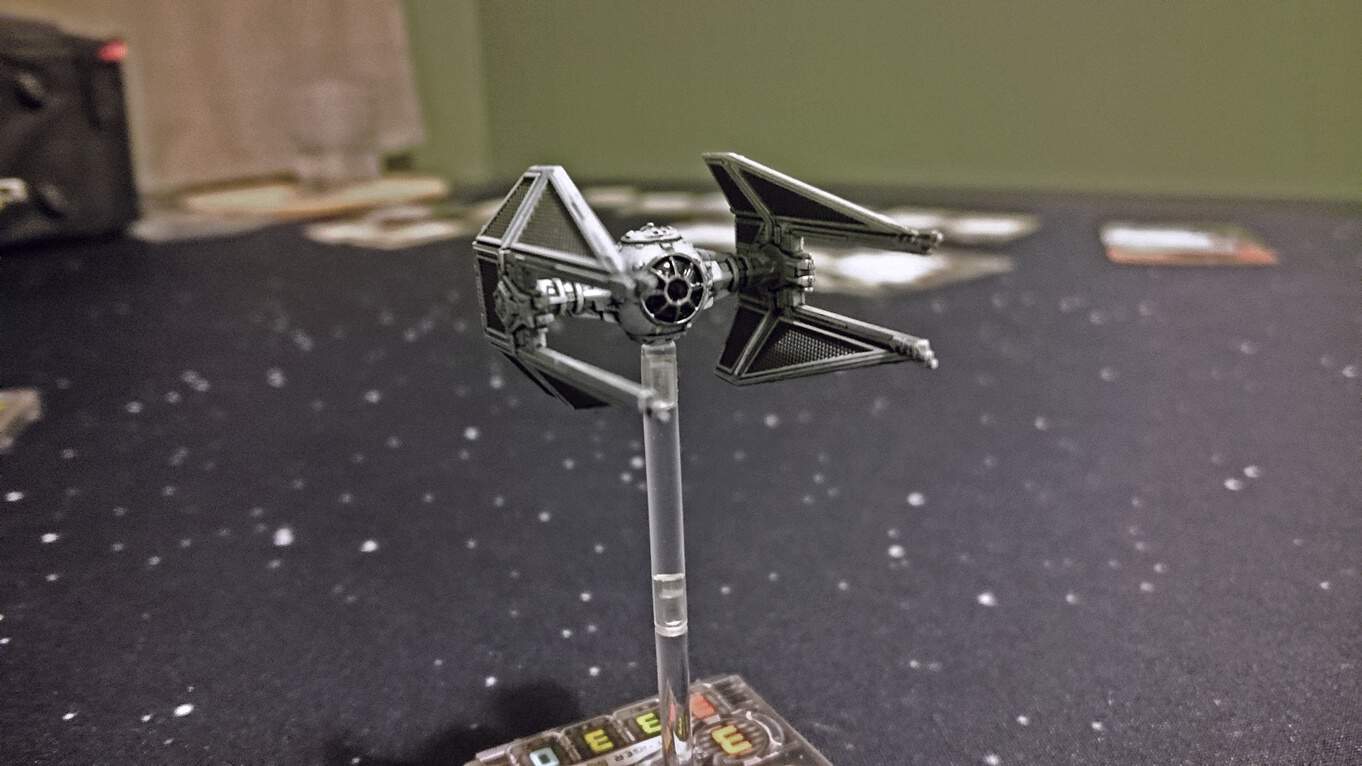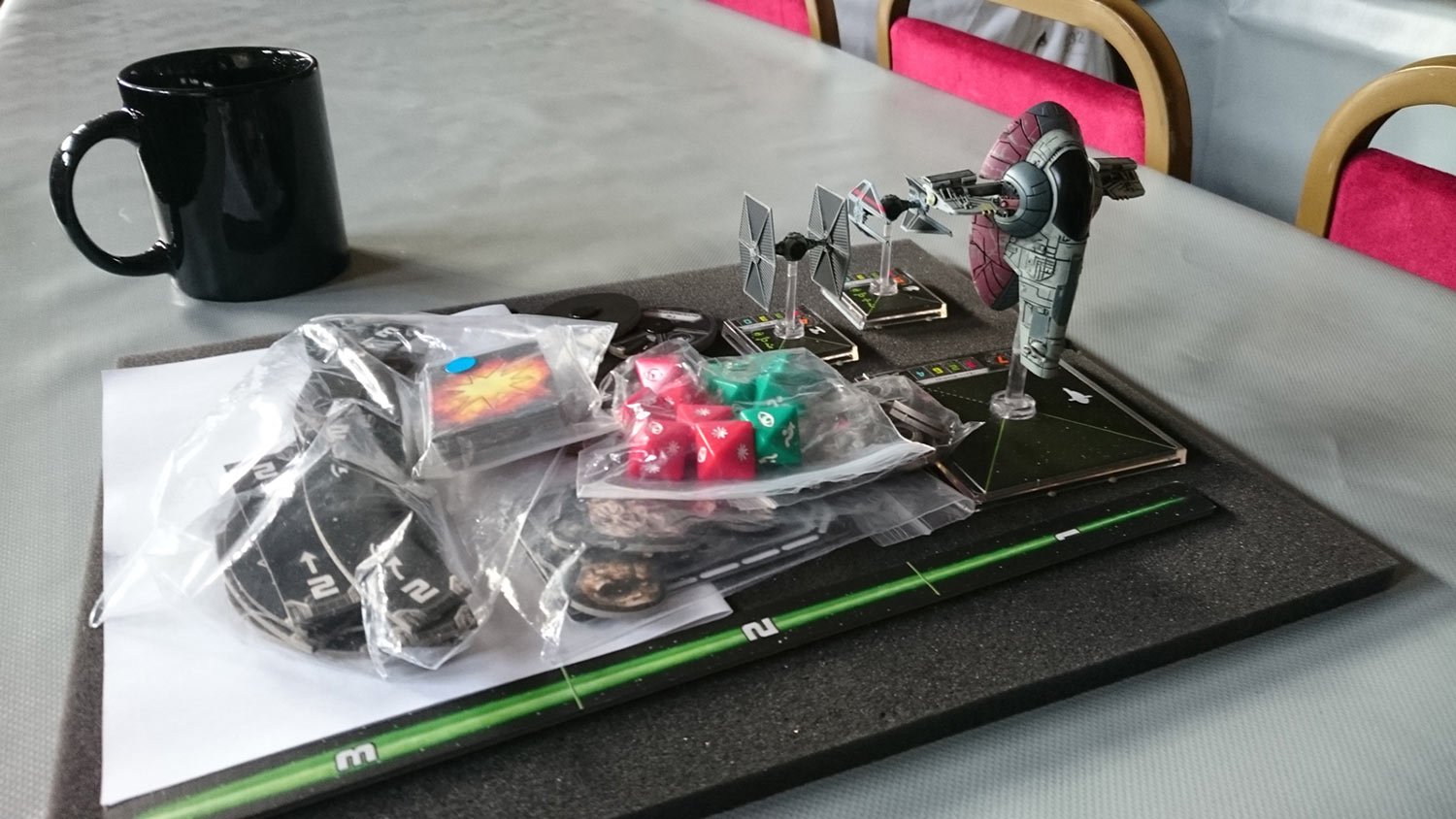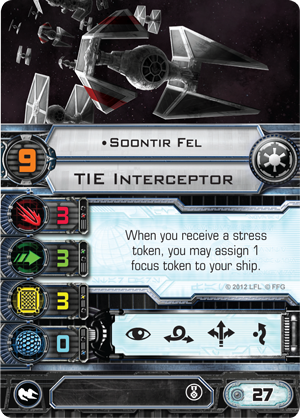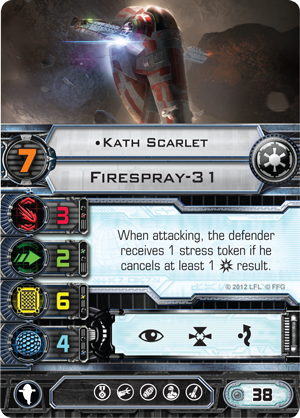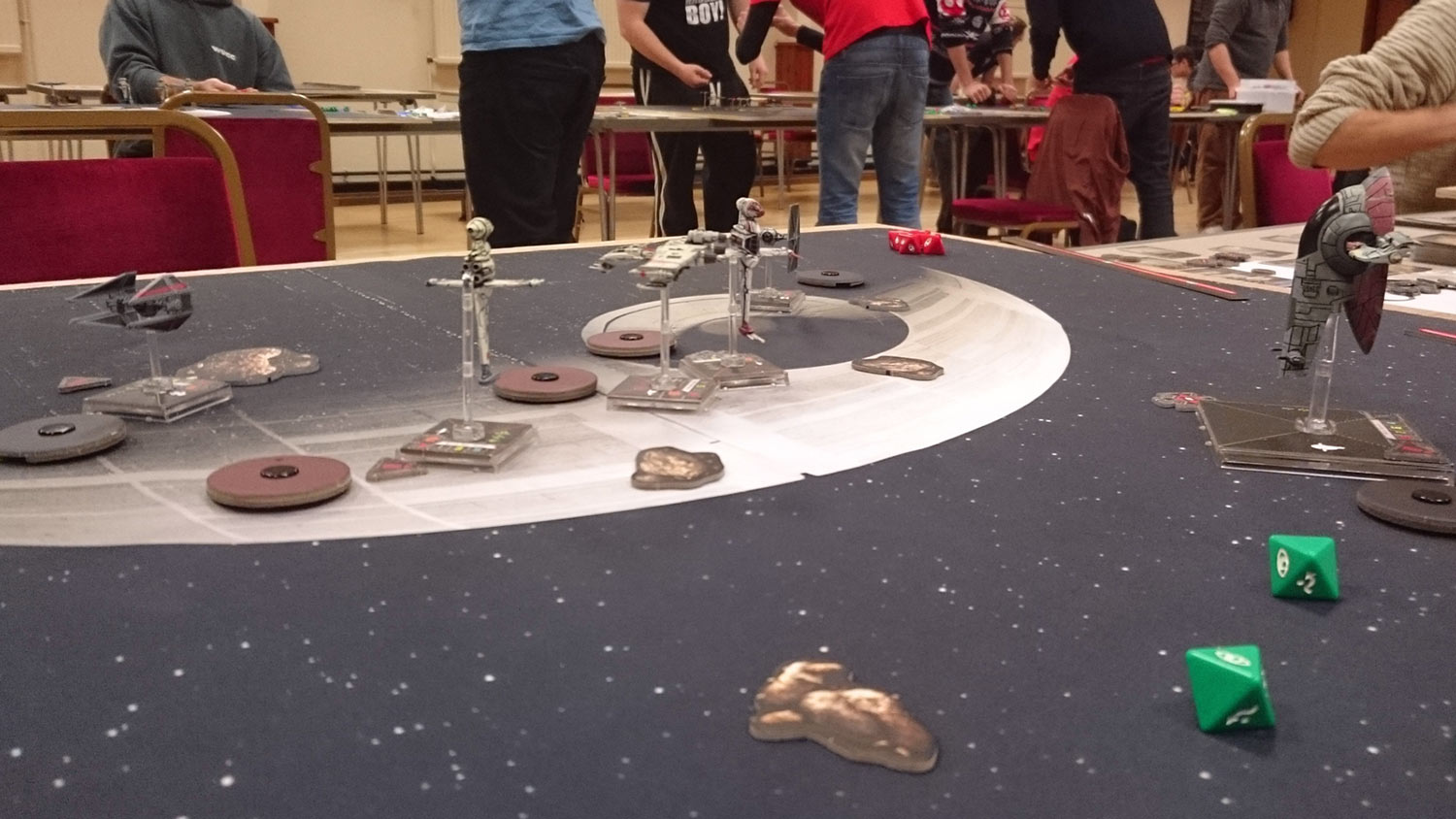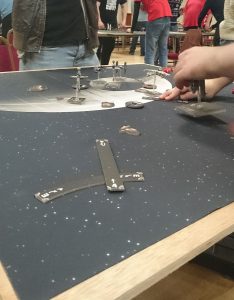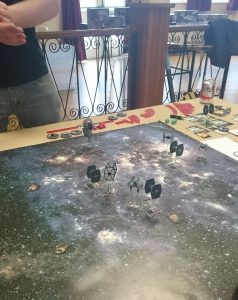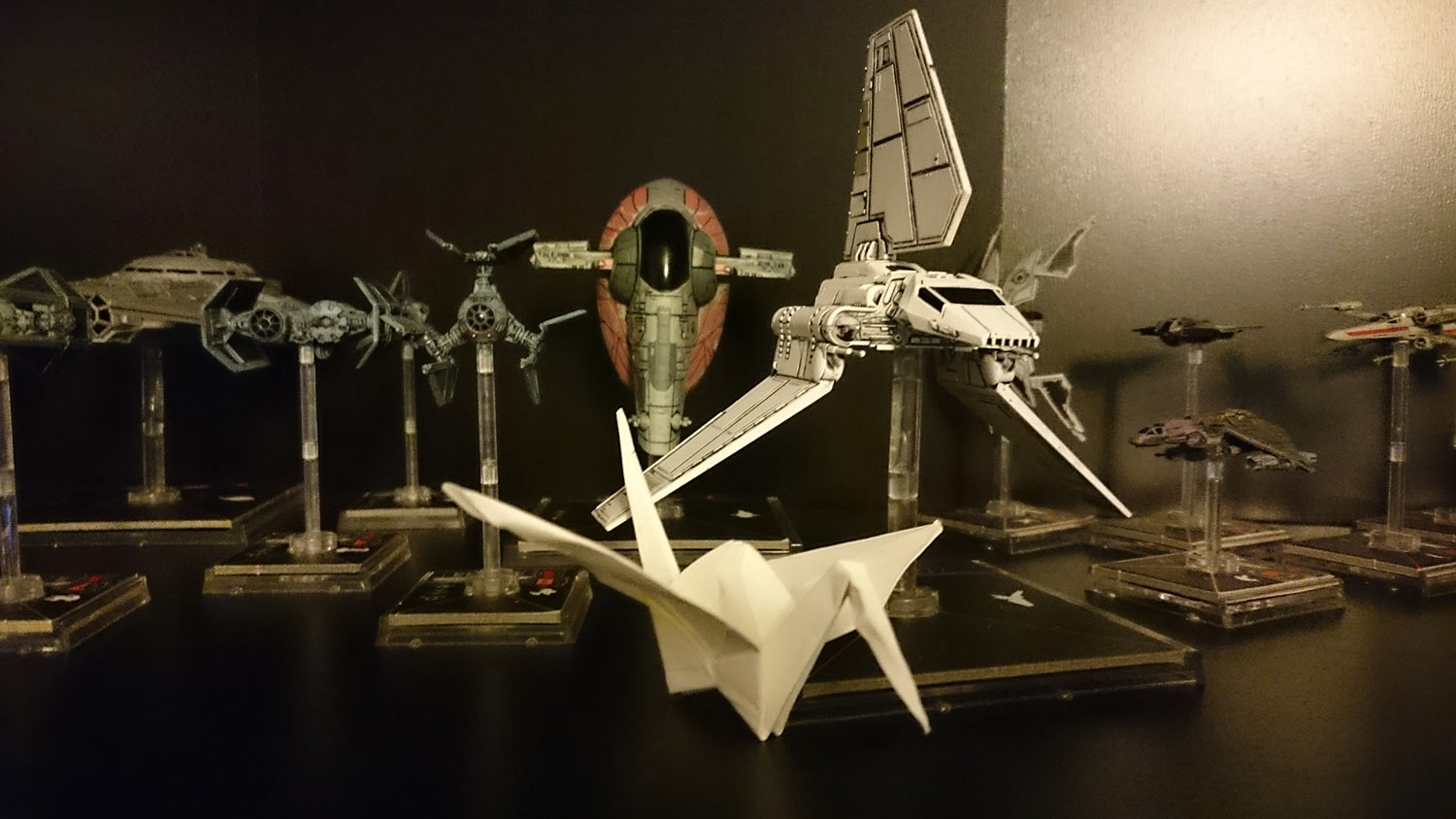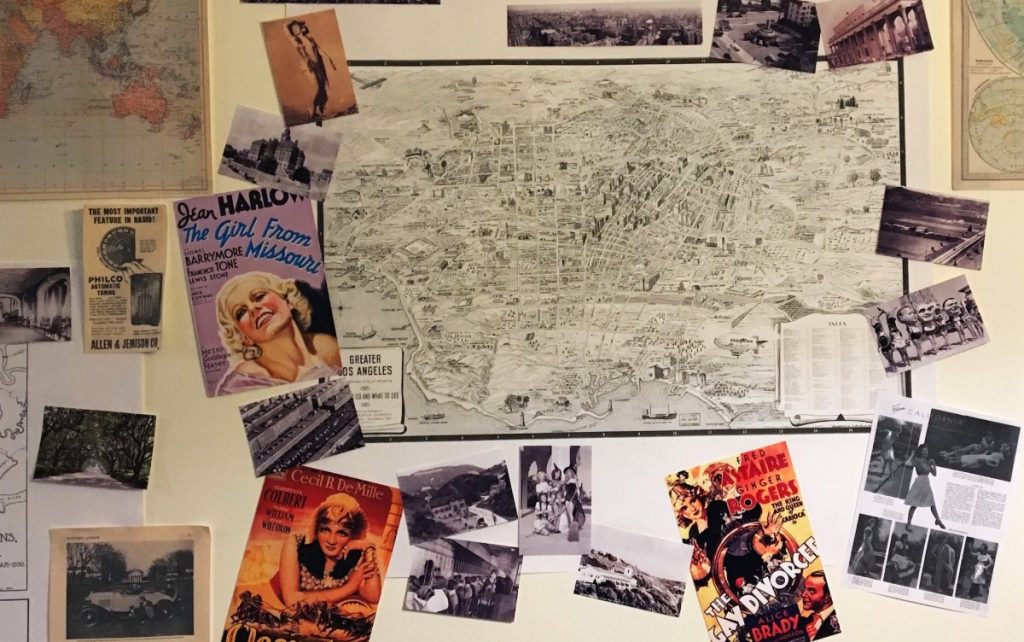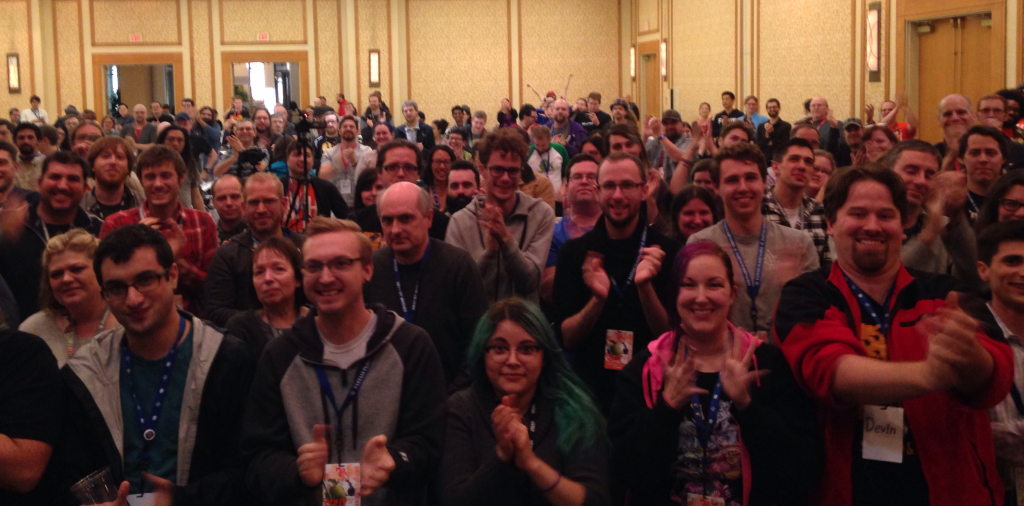[We’ve told the story of a Netrunner tournament, but what about Fantasy Flight’s biggest-selling title, the excellent X-Wing Miniatures Game? PC Gamer magazine’s Chris Thursten has just started playing, and below shares the awesome journey of his first ever tourney.]
Chris: The TIE Interceptor is everything sexy about the Galactic Empire. It’s a jagged little wedge with wings like unsheathed claws. It’s front-heavy, like a drag racer, and its hard angles make it look like a TIE Fighter that has narrowed its eyes. Like its sibling, it’s entirely without shields or life support. An Interceptor pilot is both completely powerful and completely exposed. They are also, given their Imperial provenance, completely a British character actor. That’s what I like so much about Interceptors, I think. I like to imagine the pilot wandering out of a regional repertory theatre company some time in the early 1960s before spending a couple of years slumming around the Mediterranean playing Roman officers in technicolour epics. By the late 1970s they’re wandering Elstree Studios in a sharp grey uniform and by 1980 they’re screaming into the firing line of a rebel turbolaser battery in a ship designed only to kill or to die.
You could never tell, through those unreadable insectoid black flight helmets, but every TIE pilot’s triumphant final thoughts are this: thank god I will never do a panto.
I have a mad personal lifelong love for Star Wars, particularly its visual design, its tone, the very specific feeling evoked by those rotoscoped miniatures and those actors on those soundstages at that point in time. Despite this, I didn’t consider investing in the X-Wing miniatures game until very recently – two months, ago, actually. I’d wandered into a game shop in London to buy the new Numenera supplement and walked past a display with their stock of the last few waves of miniatures. I was reluctant to look, in the way that I’m reluctant to look in the window of Games Workshop stores: there’s a lot of that-was-me-once bundled up in both miniatures and Star Wars, stuff I’d moved on from.
I let myself look, however, and that was it. It wasn’t simply the miniatures: it was these miniatures. I did a double-take when I saw the VT-49 Decimator, an Imperial gunboat designed originally for the now-defunct Star Wars Galaxies online RPG. My Decimator had been my favourite thing in a game I loved and miss. I wrote fan fiction about that thing. They had Interceptors, too, including a box containing a red Royal Guard Interceptor (not my speed; I never understood how they got those long red robes into the cockpit. Do they bunch them up around their waist, like Victorian bathers?) And a regular Interceptor with the bloodstripes of the Imperial 181st Fighter Wing from the Rogue Squadron comics.
I think they know what they’re doing, refusing to allow the prequel movies any foothold in the game while digging so deep into the old expanded universe. I looked at that display and saw the Star Wars that I loved before it all went to shit. I also saw a miniatures hobby that I’d never really been able to afford as a teenager, now affordable as a ludicrous alleged grownup with a bit of disposable income.
Something gave, and I returned to the shop a few days later with cash. A little avalanche of plastic X-Wings and TIEs slid into my possession, the result of a process like mental subsidence.
I then did what I do, which is to become very competitive.
X-Wing has a long history as a competitive game, and I am a newcomer, and so I’m not going to pretend to know the full story. This is a game that is fundamentally rather elegant, a turn-based simulation of space dogfighting that pairs the asymmetry and granularity of a miniatures wargame with the momentum of Chess or Go. Spaceships almost never stop: they bank and dodge and circle one another and strain for advantage, curving into positions of power and loss based on the judgement of their pilots. There’s no taking cover and no waiting to see what your opponent is going to do. X-Wing is all about the next move, your brain’s ability to perceive all of your opponent’s likely choices and then direct yourself into the one that kills them and not you.
As I taught myself to play the game, first by playing against myself and then by attempting to teach my friends, I was drawn to maneuvering as my favourite way to win. I understand all of the competitive weaknesses implied by having a ‘favourite’, and those are definitely weaknesses I have. I wanted to build my strategy around those little, deadly, fragile Interceptors, and win by placing them in my opponent’s’ blindspot like velociraptors converging. Clever girl.
Soontir Fel is the most points-expensive Interceptor pilot in X-Wing and epitomises this playstyle. He’s a good example of something I really admire about the game, which is the way the rules for each named pilot evoke something about their personality in the fiction. Fel was created to be the Empire’s Red Baron, a foil for cool-handed Rebel aces like Wedge Antilles and Corran Horn. He defies the survivability odds of your average TIE pilot on the basis of skill and willpower alone.
In the game, this manifests as a very simple rule: whenever Soontir Fel earns a stress token (such as by pulling off a difficult maneuver), he gains a focus token. Pressure makes him better, not worse. This has led to a single optimal build for Fel: Push the Limit plus the Royal Guard TIE title, Autothrusters and a Stealth Device. Push the Limit is the key, here, giving him two actions per round in return for a stress token. Coupled with Fel’s natural love for stress, this gives him effectively three actions – after moving he can reposition with a boost or barrel roll, or double up on defensive options with focus or evade tokens.
This loadout costs 35 points, over a third of the standard 100-point cap. Compared to other loadouts at this price point, Fel is incredibly fragile – a meagre three hull points, no shield to speak of. His survivability comes entirely through positioning and resource management, and as such he is both infuriating to fly against and incredibly stressful to fly. Fly well and he’s unstoppable; make a mistake and he’s dead and you have likely lost the entire game.
I like Soontir Fel very much. I knew that when I came to compete, he would be at the centre of whatever squadron I drew up. I joined a club, and started to fly him against experienced players, and made lots of mistakes, and then I started to win occasionally. I put a little more money down to pick up a Firespray-31 – also known as ‘that ship Boba Fett flies for two minutes in The Empire Strikes Back, which is in no other movies that we’ll speak of’. I flew it simply because I wanted to try flying it, and found myself winning with it. The Firespray is a large ship, but agile for its size. It can fire backwards. I found its (relatively) thick hull and shield reassuring, a comfortably-weighted hammer to accompany Fel’s sharp little nail.
Having been playing for a couple of weeks, I decided to attempt the tournament scene. A game store in Bournemouth, LVL UP, was hosting an event very close to me. This tournament, Stay on Target, was slightly bigger than a store championship but smaller than an official event. First prize would receive an Imperial Raider, a huge expansion set worth around sixty Great British Pounds nowadays. Runners-up would receive special acrylic tokens and range rulers. I finalised my list and packed up my things and got on the bus and walked into the chilly main hall of a sixties social club at ten on a grey November morning with my partner at my side and I thought: this is going to be difficult and I would be delighted if I perform averagely.
It was difficult and I performed averagely. I am going to skip to the end, here, briefly, because I do not want you to think this is heading in a fairy-tale-sports-movie direction that it decidedly isn’t: I placed 15th out of 27 after five rounds of Swiss. You could attempt to spin that result one way or the other with context – it was my first go, etc – but I’d rather not. I am content with the objectively-assessed averageness of me. From this middling position I feel like I’m better placed to understand my feelings about the game and the competition than I would had I been in the top half (and therefore likely somehow robbed) or the bottom few (and smiling through gritted teeth.)
When I opened my carry-case and arranged my squadron on the table in front of me, this is what I had:
A TIE Interceptor, Soontir Fel, with Push the Limit, Royal Guard TIE, Autothrusters, and Stealth Device.
A Firespray-31, Kath Scarlet, with a “Mangler” Cannon, Gunner, and Predator.
A single TIE Fighter, Black Squadron, no upgrades.
This sits somewhere south of any particular meta you could name, but it comprised ships I liked and was comfortable flying. Scarlet’s role was to barrel into opponents and draw attention from Fel while he moved in from the flank. Fel’s job was to fail to die before all the things that might kill him were dead, and then to kill everything else. The TIE Fighter was there to make up points, but I didn’t tell him that.
My first opponent was somebody from my own club who I’d never actually played against. His list comprised a swarm of TIE Fighters, including a few First Order TIEs from the new film, and a stock TIE Defender with no upgrades. In tournament play, competitors are encouraged to explain their lists to one another before they play: to reveal and explain every upgrade and point of synergy, if not their overall strategy. Coming from computer strategy games and card games, I admire this transparency. There is a moment when you encourage somebody to come around your end of the table, ask you questions about how you plan to beat them, and then you head around their side to do the same. Sometimes people murmur appreciatively or make concerned noises. It’s pleasant; it makes what follows feel like a collaboration, even when each of you really wants to win.
There wasn’t much of that, in this instance. We were both nervous. I said “here’s my list” and he only glanced at it. I glanced at his. I’d never played against a TIE Defender before, and didn’t know what it did, and it seemed impolite to ask, so I didn’t.
This game was relatively quick. His TIE swarm was most dangerous in the early stages of the game, when massed fire could tear through Scarlet or – if I couldn’t keep him out of the way – Soontir Fel. I flew Fel up one side of the board and sent Scarlet and the TIE up the middle. As my opponent revealed his second round movement dials I realised that it was probably my game to lose. He’d dialed-in the same banking turn for all of his tightly-packed TIEs. Due to a quirk in geometry, this doesn’t work: you can transpose a cluster of squares in a straight line without an issue, but as soon as they turn they will begin to overlap one another unless each square moves a different distance. In X-Wing, overlapping results in a ‘bump’ – and a bump is about the worst thing that can happen to you. A bump means you can’t take an action, which means that you are at the mercy of your dice.
Scarlet and my TIE took out one of his TIEs in that initial joust at the cost of Scarlet’s shields. His swarm split after that, Fel moved in, and I was able to take them on a few at a time until only the Defender and a single TIE remained. The Defender fell first, then the TIE, and I had won a game of X-Wing.
I stepped back from that table knowing that I’d been relatively lucky, but that luck would cost me in the next round. Swiss tournaments pair winners with winners: if I was very lucky, I’d be matched with somebody else who had been fortunate in the first round but was otherwise out of his depth. More likely I’d be matched with a real winner, someone destined for the top tables. I understood that I would probably lose my second game.
I lost my second game.
I waddled over to the table, cradling my cards and miniatures in a sheet of foam padding in a manner that trod a fine line between efficiency and haplessness. My opponent had beautiful custom miniatures – a YT-1300 freighter (think Millenium Falcon) and an E-Wing fighter – and a list that I looked at but didn’t read or understand. He looked at mine and said nothing. Then, he asked me if I had been playing for a long time, if I was good. He explained that he kept getting matched with new players, and that it had been a while since he had found a good or challenging game. I said that I had been playing for a month. It felt like a punchline.
I should stress that this didn’t really feel patronising or intimidating at the time. There is a sort of uncertain swagger to hobby gaming that I encountered a lot as a teenager, a way that men talk to one another when they want to establish both a rapport and a hierarchy at the same time. As somebody who has always been small and who didn’t really gain a strategic mind until well into his 20s, I am used to power dynamics like this. It’s fun, even, like getting to do a victory lap around psychological stomping ground that I’ve been through before and ultimately moved past.
I placed my miniatures on the board and raced them towards him, Scarlet first. He did something I’ve never seen, which was to orient his E-Wing, Corran Horn, sideways. It looked clever. I went for the smaller ship first, in order to remove it from play so we could focus on whittling down that tough YT-1300 freighter. I smacked my TIE Fighter into an asteroid, which was embarrassing, and then Scarlet died. Corran Horn, it turns out, can shoot twice in a single turn at the cost of not being able to fire in the next. I simply didn’t account for this, and my Firespray took something disgusting like three hits from the YT-1300 and eight from Corran, four of which were critical hits. Scarlet exploded, my hammer shattering on impact.
Then I lost my TIE Fighter, almost as an afterthought.
At the beginning of the third round, ten or fifteen minutes into the game, only Soontir Fel remained. Killing either of his ships at this point was impossible. The YT-1300 freighter, Chewbacca, was immune to critical hits and could reliably summon an evade result on his dice. The E-Wing, Horn, regenerated shields every time it performed a gentle turn thanks to R2-D2. An Interceptor does not win a war of attrition. I considered folding.
In tournament X-Wing, matches are played against a 75 minute time limit. Just under an hour was left. If a game is still ongoing when time is called, the final round is played out and a winner is declared based on the amount of points they’ve managed to destroy of their opponent’s ships. These points also determine your ‘margin of victory’ – in the event that multiple players have the same number of wins, which is likely in Swiss, then it’s this more granular margin that is used to determine overall placement. Optimistically, then, if I won my next three games then my position could be determined by how many points I managed to eke out of this one. If Fel died, I’d get nothing. If he survived, I would at least deny my opponent an extra 35 points on his margin.
So I ran away. For an hour.
I blasted Fel past his YT-1300 freighter and into the corner of the board, then turned and shot down the other side. The dice started to go my way, but only on defense, and I made it to the far corner just as he managed to get both of his ships into a good firing position from two different angles. By this point other games had started to finish, and our match drew a small crowd. I knew that he expected me to clear Soontir Fel’s stress token with an easy move, then attempt to dodge with boosts and barrel rolls. Instead, I revealed a mad straight dash, blasting out of range and forcing him into another two rounds of adjustments. I kept this chase going, and going, and going. We got talking, about the game, and my opponent mentioned that he has a thing about always coming fourth in these sorts of tournaments. I tried to look sympathetic, and kept running.
He pinned Fel down in another corner, but Corran missed with both rounds of shots and wouldn’t be able to shoot in the next turn. In response I turned hard into Chewbacca, reversing that moment in Return of the Jedi when Lando protects the Rebel fleet by ordering them to move in closer to the Empire’s looming Star Destroyers. The next round began just as time was called. Corran couldn’t shoot. Fel, having bumped Chewbacca, couldn’t shoot. Chewie couldn’t shoot. Nobody could shoot. It was over. I had guarded my margin of victory (loss, really), for an hour.
Later in the day, my opponent would finish fourth, though by more than 35 points – this game would not have made a difference. Still. It felt a little like a punchline.
The third game was lovely, compounding my sense that a game of X-Wing – even when it is competitive – is something that two players build together. My opponent and I found seats, laid out our squadrons, took the strain off for a full hour as the game went to the full seventy minutes. We talked about what we each liked most about the game, about our lists and the ways we liked to play. His side was built around a durable Rebel K-Wing pilot, Miranda Doni, who I have always struggled against. She can regenerate shields by sacrificing her firepower. I have never really known what to do about that kind of durability, as somebody who likes Interceptors. Nipping at her shields as she glided around, I felt like a dog trying to kill a car.
Eventually it was just Miranda and Fel, circling one another. Interceptors do not win wars of attrition. When time was called, I had lost the game by a margin of six points.
My fourth opponent ran three Interceptor aces, including his own Soontir Fel, identical to mine. His experience of the tournament so far had been very similar, including some of the same opponents. The asymmetry of our lists was interesting to resolve. He moved all of his Interceptors in on Scarlet, first, as my Fel shot around to his side of the board and back down again. In a vital early error, my Firespray managed to block his Soontir Fel in with his other Interceptors in a narrow passageway between asteroids. She took the full brunt of his firepower in a single turn, a devastating amount of damage that she’d barely limp away from. My Soontir Fel, however, got the opportunity he needed. I drew him right back down the board, boosted and barrel-rolled him into a killing flanking position on his mirror-matched counterpart. Fel slew Fel. Clever girl.
I lost Scarlet after that, however, and then a bad roll cost me my TIE Fighter in a joust that, had it gone differently, could have turned the entire game. Fel found himself pursued by Royal Guardsman Carnor Jax and fellow Interceptor ace Turr Phennir with forty minutes on the clock. I had a shot, this time, a narrow one, but my focus still had to be on protecting Soontir Fel and my margin of victory.
Leaning over that board, straining to visualise all of my opponent’s possible ending positions, his firing arcs and my own, I felt my brain and my legs start to give out. I felt the heat and strain of over-thinking. I had been calculating Fel’s position, round after round, for most of a day. A win here would put me back on an even footing, but did it really matter? I looked up and from where we were playing I could see my partner, sat at the side of the hall, reading. She turns into a bundle of hat and coat and scarf when she is cold, and she gets cold a lot, and I could just about see her eyes, narrowed in concentration, looking at a magazine. She might be bored, I began to worry. I could stretch these games out, but should I? I had lost two already; my margin of victory was no longer that important.
I looked back at the playmat and something shifted. This will sound like such a cliche, and it is almost embarrassing to write, but there is something that clicks in my mind from time to time, when I am under stress and concentrating, and I gain access to a clarity of thought that I do not usually possess. I have always had quite good spatial awareness. I love speed and chance and precision and energy, anything imparted by the phrase ‘push the limit’. I think George Lucas does too – it is no accident that he went from making movies about drag racing to movies about the fastest starships in the galaxy – and maybe sharing that love is why I get as much out of Star Wars as I do.
I looked at the board and understood that I could continue running. I also saw that, in all likelihood, my opponent was about to turn both Carnor Jax and Turr Phennir into position behind Soontir Fel on the next turn. Fel may well survive, but Phennir only had one hull point remaining – the point that my stricken TIE Fighter had failed to remove. I could run, but I could also take my chances screaming into the line of fire. My margin of victory no longer mattered. I could win this game.
I dialed in a hard 180, what X-Wing players call a ‘K-turn’. It causes stress: Fel would get his free focus token, but nothing else. If I could kill Turr Phennir before Phennir killed me, I would end up ahead on points. Then, I would need to survive against Carnor Jax. If I did so, I could fight or run, but I would be ahead on points. It was up to the dice, but I did not mind because I liked my opponent and if I was going to win I wanted to win like this, I wanted to win well.
I rolled. Fel’s attacks came up short; Phennir survived. Jax fired, then Phennir, and Soontir Fel, well, fell.
I walked over to where my partner was sitting and took a seat next to her. We got to sit together for a little bit, before my next game, and we talked about what she was reading. It was a magazine about fish.
My fifth opponent laughed when our names were drawn. He was also from my club, and we had practiced together with these exact lists only a few days before the tournament. He had won. He ran Miranda Doni with B-Wings, elegant gunboats with plenty of shields, cars for my dogs to chase. I had lost that practice game in part because I’d doubled-down on killing Miranda and failed: afterwards, somebody had sagely advised me to focus on the weaker ships if I found myself in that position again. I walked into that fifth game very tired but content in a way that is hard to describe. I felt very, very focused. I felt like I understood the game and the list and my own limits, and that I had discovered that I become more confident and capable under pressure. That feeling that I could ‘see’ the board carried over from the fourth game. I wanted a second and final win.
He flew his ships in tight formation, which I had expected. I stuck to my own plan, bringing Scarlet and the TIE into position together while Fel arrived from the back. In the first round of shooting I crippled his named B-Wing, Ibtisam, and took no casualties. All our our ships were poised in a huddle, mine on the outside, his inside, flanked by asteroids. On the next round I revealed three K-turns, my ships pulling long 180s that took that deadly triangular firing solution and flipped it. Three stress tokens, plus Fel’s focus. We fired again: I lost the TIE fighter, but the TIE fighter destroyed Ibtisam. His other B-Wing was in tatters, and died the round after.
Miranda ran, but I still had Kath Scarlet and Soontir Fel had escaped her fire for the time being. I drove Scarlet hard back down the centre of the board, between two asteroids, comfortably in range of Miranda. In the same turn I moved Fel back around, barrel rolled, and boosted – and somehow that final boost maneuver pushed Fel through the narrow gap between Scarlet and asteroid and into formation alongside his squadron-mate, firing solution and all. If you are reading this, Lewis, I know that at the time I did a little smirk like ‘I meant to do that’. I didn’t mean to do that. It was an accident, something that came about the moment my confidence tipped over from I know what I’m doing to screw it what’s the worst that could happen.
Fel fired, Miranda fired, Scarlet fired, and Miranda died. I had won my fifth and final game. I had placed averagely.
When I got home my legs wouldn’t work. I sat down on the kitchen floor for a bit, and then on my bed. My partner asked me to close my eyes and hold my hands out for an early Christmas present. There had been a bench full of miniatures for sale at the tournament, and during those later rounds as I had been hunched over staring at the board she had snuck off and bought me ships she liked. She presented me with my own TIE Defender (‘a crab with a mohican’), a Lambda Shuttle (‘an origami crane’), and a VT-49 Decimator – she had been with me when I had first seen it in the store in London. I had told her about the fan fiction.
I have retired Soontir Fel, for now. He has spent the last few weeks on a shelf, guarding a ticket for a midnight showing of The Force Awakens.
My new squadron is a Decimator and a Defender.

